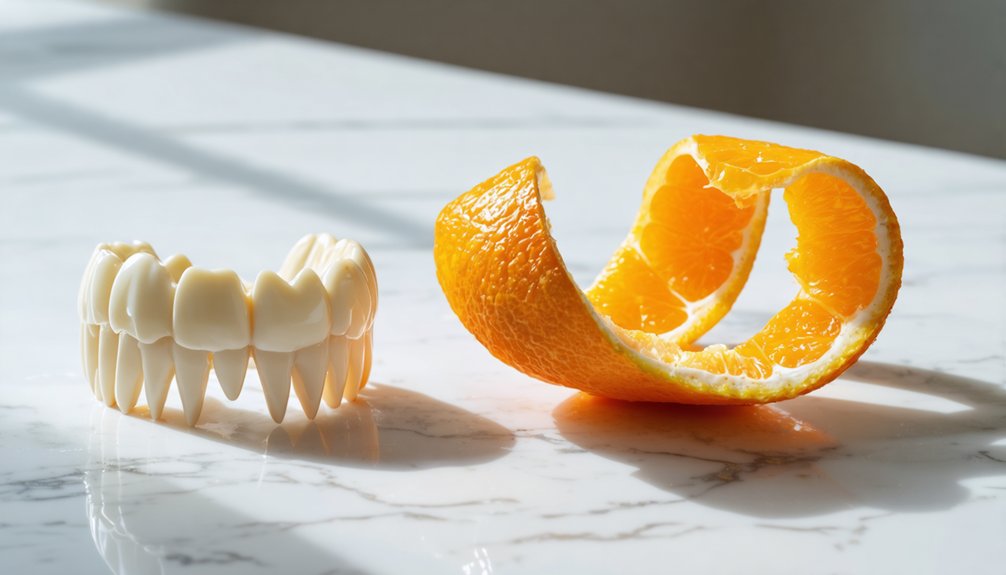You can use orange peels for DIY teeth whitening due to their natural compounds like citric acid and d-limonene, which help break down surface stains. The citric acid acts as a mild bleaching agent while d-limonene dissolves stubborn discoloration, particularly from nicotine. While less powerful than professional treatments, orange peels also provide antimicrobial benefits for oral health. However, understanding proper application methods and potential risks will help you achieve ideal results safely.
Key Takeaways
- Orange peels contain d-limonene, a natural solvent that effectively breaks down surface stains, particularly nicotine discoloration.
- The citric acid in orange peels acts as a mild natural bleaching agent and antibacterial compound for gentle stain removal.
- Rich in vitamin C and flavonoids, orange peels provide antioxidant benefits while supporting overall oral health.
- Orange peels offer a cost-effective, natural alternative to commercial whitening products with centuries of traditional use.
- At 5% concentration, orange peel extract shows optimal whitening results when applied consistently over approximately 28 days.
The Science Behind Orange Peel’s Whitening Properties
While orange peels have gained attention as a natural teeth whitening method, their effectiveness primarily stems from their citric acid content. This natural compound acts as both a mild abrasive and antibacterial agent, helping to dissolve surface stains while reducing bacteria on your teeth.
When you use orange peel for teeth whitening, the citric acid works to break down discoloration through a gentle chemical reaction. Research has shown that orange peel extract can produce whitening effects, though not as dramatic as commercial products. Studies indicate that 5% concentration levels produce optimal whitening results.
You’ll find the most benefit from controlled application, as the concentration of citric acid matters considerably. However, you should exercise caution, as frequent exposure to citric acid can potentially harm your tooth enamel over time, making moderation essential for maintaining dental health. The d-limonene compound found in orange peels shows particular effectiveness in removing nicotine stains from teeth.
Key Chemical Compounds in Orange Peels
When examining orange peel’s whitening properties, you’ll find citric acid acting as a natural bleaching agent while contributing to the breakdown of surface stains on your teeth.
The aqueous extract contains phenolic compounds which provide additional stain-fighting benefits. D-limonene, the primary essential oil component making up a significant portion of the peel’s volatile compounds, works as both a cleanser and natural whitening agent through its ability to dissolve stubborn stains.
The peel’s natural stain-fighting compounds, including flavonoids and vitamin C, work synergistically to provide antioxidant effects while helping to prevent new stains from forming on your teeth’s surface. The high concentration of total flavonoids at 5.67 grams per 100g provides potent natural whitening capabilities.
Citric Acid Properties
Citric acid, a naturally occurring compound found abundantly in orange peels, possesses a complex molecular structure (C₆H₈O₇) with three carboxyl groups and one hydroxyl group. This natural acidulant functions as a powerful chelating agent, binding to metal ions in dental stains while adjusting pH levels in oral applications.
When you’re considering orange peel for teeth whitening, understand these key properties:
- It’s highly water-soluble, allowing it to effectively penetrate surface stains.
- Its chelating properties help break down plaque by binding to calcium and other metal ions.
- Its three pKa values (3.13, 4.76, and 6.40) provide buffering capacity across different pH levels.
However, you’ll need to use it cautiously, as prolonged exposure to its acidic nature can potentially affect tooth enamel through demineralization. Solutions of citric acid begin to decompose above 175°C, making it stable and effective at normal oral temperatures.
D-Limonene’s Whitening Effects
Beyond citric acid, d-limonene stands as the primary chemical compound responsible for potential teeth whitening effects in orange peels.
You’ll find this natural solvent particularly effective at breaking down surface stains caused by coffee, tea, and tobacco. While studying d-limonene benefits, researchers have found it works by dissolving extrinsic stains without damaging your tooth enamel like harsh abrasives might.
However, don’t expect dramatic results overnight. The stain removal process through d-limonene is gradual, requiring consistent application over time. Like activated charcoal toothpaste, d-limonene needs about 28 days of regular use to show significant whitening effects.
Laboratory studies show it’s less powerful than professional whitening treatments but safer than many DIY alternatives. When you’re considering orange peel for teeth whitening, remember that d-limonene targets only superficial discoloration and won’t affect your tooth’s natural color. Recent studies have shown that banana peel may actually be more effective than orange peel for natural teeth whitening.
Natural Stain-Fighting Compounds
Inside orange peels, you’ll find several powerful compounds that work together to combat tooth stains naturally. The citric acid serves as a natural whitening agent, while flavonoids provide antioxidant benefits that support overall oral health. Orange peels are particularly rich in d-limonene compounds that can help remove surface stains. Volatile oils contribute to freshening your breath while participating in the stain removal process. Scientific research shows that orange peels deliver minimal whitening effects compared to professional treatments.
- Citric acid actively breaks down surface stains on your teeth by penetrating discolored areas and lifting unwanted pigments.
- Flavonoids work as protective compounds that help prevent new stains from forming while supporting your tooth enamel’s integrity.
- Saponins create a mild cleansing effect that enhances the overall stain-fighting power of orange peels when used as part of your oral care routine.
Remember to use these compounds sparingly, as their acidic nature can affect your enamel with prolonged exposure.
Traditional Uses and Cultural Significance
While orange peels have a long history in traditional medicine systems like Ayurveda and Traditional Chinese Medicine for general oral health, they weren’t specifically used for teeth whitening until modern times.
You’ll find that many cultures, particularly in Southeast Asia and Africa, incorporated citrus fruits into oral care rituals due to their association with cleanliness and purity.
Today’s DIY teeth whitening trends using orange peels represent a modern interpretation of these traditional practices, though they’re primarily driven by social media rather than historical precedent. The active compound d-limonene in orange peels has shown promising results for removing certain types of tooth stains.
Historical Home Remedies
Throughout centuries of folk dentistry, orange peel has served as a readily available natural remedy for teeth whitening and oral hygiene.
Historical practices reveal that cultures worldwide combined orange peel with other natural substances to enhance cleaning effects, while cultural beliefs emphasized its symbolic role in purification rituals.
Before modern dental products emerged, people relied on these traditional methods for their accessibility and effectiveness:
- Rubbing fresh orange peel directly on teeth to utilize its natural abrasiveness and stain-removing oils
- Mixing dried citrus peel with salt or charcoal to create a more potent cleaning paste
- Applying the peel intermittently rather than daily to protect tooth enamel from acidic exposure
These time-tested remedies often aligned with holistic health systems that valued natural ingredients for maintaining oral hygiene.
Global Cultural Practices
The cultural legacy of orange peel in oral hygiene extends far beyond simple home remedies, shaping diverse traditions across continents.
You’ll find orange peel integrated into oral rituals throughout Asia, where it’s valued as a natural astringent for teeth cleaning, while African communities incorporate dried peel powders into indigenous cleaning tools.
In traditional Chinese medicine and Mediterranean healing practices, orange peel’s significance transcends mere oral care, representing holistic wellness and natural purification.
Cultural traditions worldwide embrace the peel’s properties differently – from Southeast Asian communities using it to combat nicotine stains to Latin American practices of creating whitening pastes.
While modern scientific support remains limited, these cultural practices persist through generations, particularly in rural and low-resource settings where natural solutions hold deep cultural meaning.
Potential Benefits for Oral Health
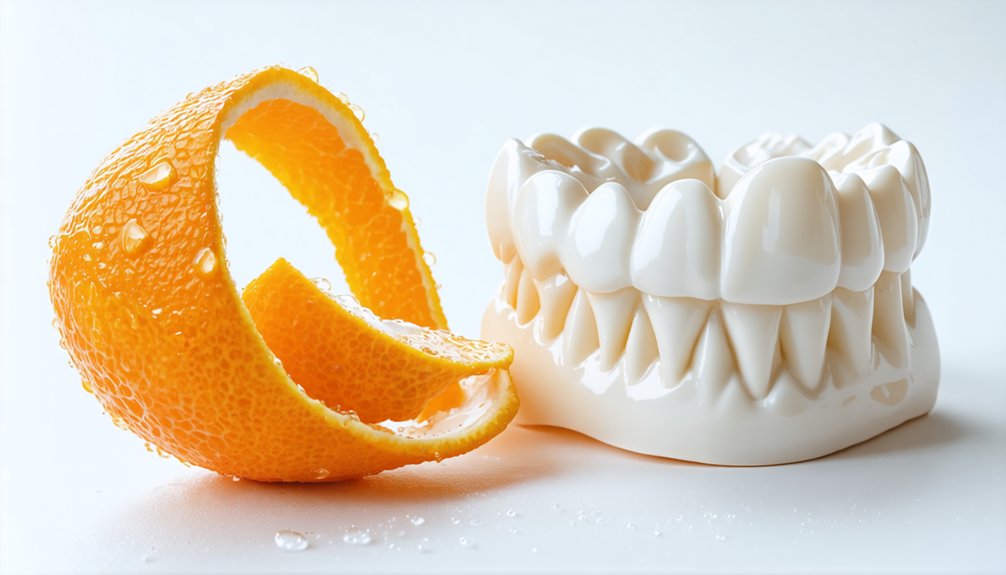
Research suggests orange peels offer several potential benefits for oral health due to their unique composition of bioactive compounds. Their antimicrobial properties, derived from citric acid and limonene, may help create a healthier oral environment by reducing bacterial growth and balancing pH levels in your mouth.
- The vitamin C content in orange peels supports gum health and boosts your immune system’s ability to fight oral infections.
- Natural compounds like d-limonene work as solvents that can help break down surface stains while providing antimicrobial benefits.
- Bioactive compounds in the peel provide antioxidant protection against oxidative stress in your oral cavity.
When considering natural remedies for teeth health, orange peel’s combination of nutrients and antimicrobial properties makes it a potentially beneficial addition to your oral hygiene routine.
Understanding the Risks to Dental Enamel
While orange peels contain beneficial compounds for oral health, their acidic nature poses significant risks to dental enamel. Your teeth’s protective outer layer can suffer serious damage when exposed to the citric acid in orange peels, which typically have a pH between 3 and 4.
This acidic environment leads to enamel erosion, weakening your teeth’s natural defense system against decay and damage.
You’ll notice increased tooth sensitivity as the acid wears down your enamel, making your teeth more responsive to hot, cold, and sweet stimuli.
When the enamel thins, it exposes the underlying dentin, leaving your teeth vulnerable to cavities and bacterial infiltration.
If you combine orange peel use with immediate brushing, you’re actually accelerating the damage, as the softened enamel becomes more susceptible to mechanical wear.
How to Safely Apply Orange Peel on Teeth
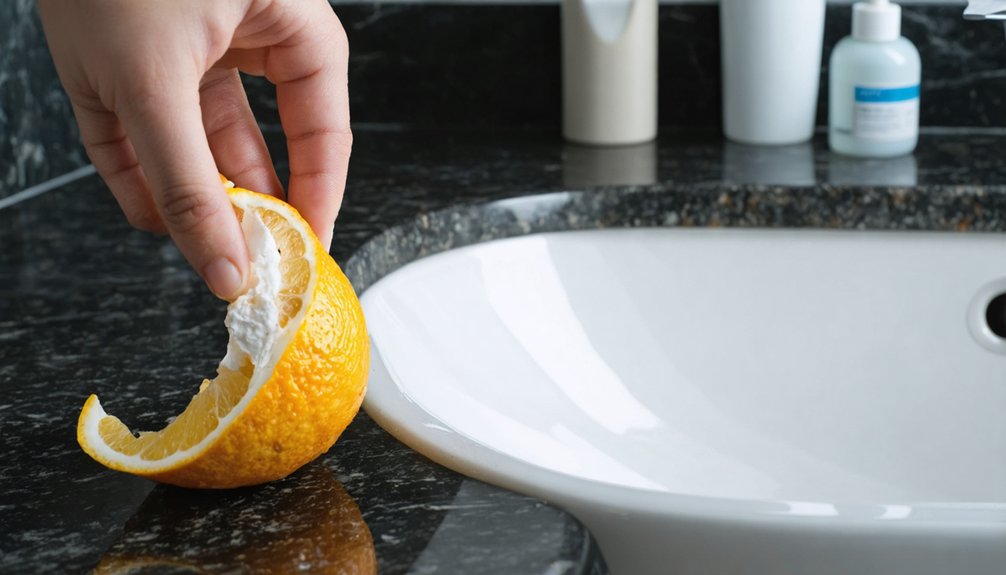
Safe application of orange peel for teeth whitening requires careful preparation and precise technique to minimize potential risks.
You’ll need to focus on proper application techniques and safety precautions to protect your dental health while pursuing natural whitening results.
- Use only organic oranges and thoroughly clean the peel’s exterior before removing the white inner portion, which contains the active whitening compounds.
- Apply the treatment by either rubbing the fresh white peel directly on your teeth for two minutes or gently brushing with dried orange peel powder using a wet toothbrush.
- Follow up immediately with thorough rinsing using water or fluoride mouthwash to neutralize acid exposure, and limit applications to once daily to protect your enamel from potential erosion.
Research and Clinical Evidence
While laboratory studies show that orange peel’s d-limonene and citric acid compounds can affect tooth color, with 5% citric acid concentration from tangerine peel showing the highest whitening potential in vitro, you’ll find the clinical evidence remains limited.
You should note that controlled trials indicate d-limonene alone provides minimal whitening benefits, proving more effective at preventing new stains than removing existing ones.
The research also reveals that orange peel’s acidic components may pose risks to your enamel, potentially offsetting any whitening advantages through erosive damage.
Laboratory Studies Results
Laboratory studies examining orange peel’s whitening properties have yielded mixed results across multiple components.
Research shows that while d-limonene from orange peel offers some stain-preventing benefits, it’s less effective against established stains. The citric acid component demonstrates higher whitening potential but raises concerns about enamel safety.
- Tangerine peel’s citric acid at 5% concentration achieved the highest whitening efficacy in controlled tests, measured using the VITA Classical Shade Guide.
- D-limonene combined with Perlite showed promising stain removal results, though d-limonene alone had limited impact.
- Laboratory experiments revealed that orange peel’s acidic nature can weaken tooth enamel, potentially causing long-term damage that outweighs short-term whitening benefits.
These findings challenge common whitening myths and suggest careful consideration before using orange peel for teeth whitening.
Clinical Trial Limitations
Current research examining orange peel’s teeth whitening properties faces significant methodological limitations in clinical trials.
The most notable clinical trial challenges include extremely small sample sizes, ranging from just 18 to 90 participants, which severely restricts the ability to draw broad conclusions about effectiveness.
You’ll find that most studies use split-mouth designs that don’t fully capture whole-mouth effects, and follow-up periods are typically too short to assess long-term impacts on enamel health.
The lack of standardized protocols for using natural remedies like orange peel makes it difficult to compare results across different studies.
Without proper controls for variables such as application pressure, contact time, and individual oral health factors, researchers can’t definitively establish safety parameters or whitening benefits for home use.
Comparing Orange Peel to Commercial Whiteners
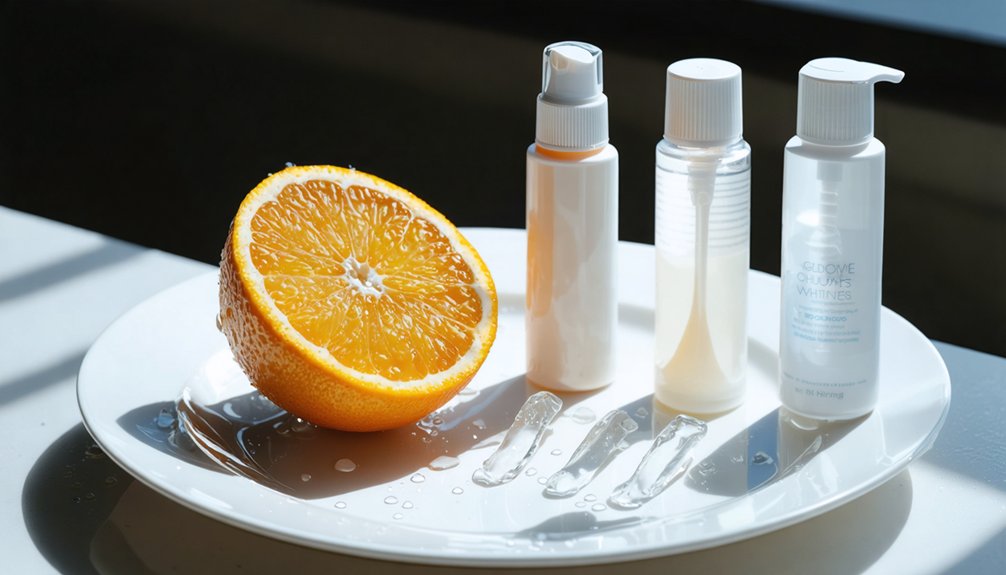
Because natural remedies often appeal to health-conscious consumers, it’s important to understand how orange peel whitening compares to commercial alternatives.
While orange peels contain d-limonene, which offers mild stain-removing properties, their whitening effectiveness is limited compared to professional products. Commercial whiteners consistently deliver superior results through concentrated formulas and controlled application methods.
- Commercial whiteners use powerful oxidizing agents that penetrate deep into enamel, while orange peel only addresses surface stains.
- Professional products often include enamel-protecting ingredients like fluoride, whereas orange peel’s acidic nature may cause erosion.
- You’ll achieve faster, more noticeable results with commercial whiteners compared to the minimal, short-term effects of orange peel treatments.
When advising clients about teeth whitening options, consider recommending professionally formulated products for maximum safety and effectiveness.
Professional Dental Perspectives
Dental professionals have raised significant concerns about the growing trend of orange peel teeth whitening. They warn that the citric acid in orange peels can severely erode your tooth enamel, leading to increased sensitivity and vulnerability to decay.
While you might notice a temporary whitening effect, it’s actually caused by the removal of protective enamel layers – a dangerous trade-off for your dental health.
You’ll find that dentists strongly discourage this DIY practice, as it lacks scientific evidence for meaningful whitening benefits. Instead, they recommend professional treatments or approved at-home products with controlled peroxide levels.
If you’re committed to natural approaches, focus on safe alternatives like crunchy fruits and vegetables that can help clean teeth without risking acid erosion.
Regular dental check-ups and proper oral hygiene remain your best path to maintaining white, healthy teeth.
Natural Alternatives for Teeth Whitening
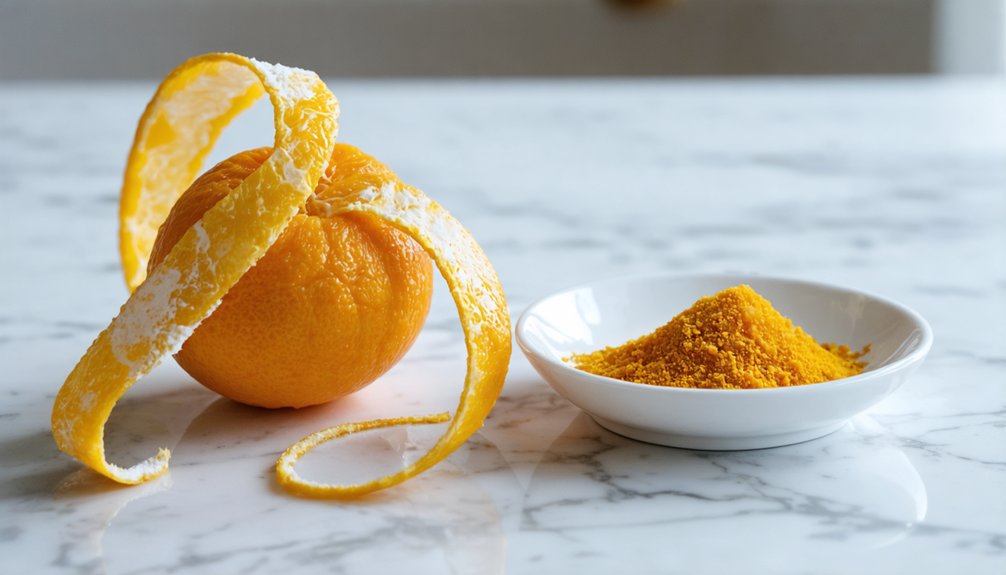
While many people seek natural alternatives to professional teeth whitening, it’s crucial to understand both the benefits and risks of common household ingredients. When considering orange peel or other natural whitening methods, you’ll need to weigh their gentler approach against their limited effectiveness compared to professional treatments.
- Natural whitening agents like baking soda and activated charcoal can remove surface stains but require careful application to prevent enamel damage.
- Acidic ingredients found in citrus peels may brighten teeth temporarily but can erode enamel when used frequently.
- You’ll achieve better results by combining natural methods with proper dental hygiene while avoiding prolonged exposure to acidic substances.
Remember that natural alternatives work best for maintaining already white teeth rather than treating deep discoloration, and you should always prioritize protecting your enamel’s integrity.
Frequently Asked Questions
How Long Does It Take to See Results From Orange Peel Whitening?
Like morning sunlight breaking through clouds, orange peel benefits for natural whitening appear within 3-7 days of consistent use, but you’ll notice only mild, temporary results without sustained application.
Can I Use Dried Orange Peels Instead of Fresh Ones?
You can use dried orange peels, but they won’t offer the same fresh advantages. While dried benefits include longer storage and powder form versatility, fresh peels contain more active whitening compounds.
Will Orange Peel Whitening Work on Artificial Dental Crowns?
You won’t see whitening effectiveness on artificial crowns with orange peels. Their ceramic or resin structure doesn’t respond to natural whitening agents like natural teeth do. Seek professional cleaning instead.
Should I Brush My Teeth Before or After Using Orange Peel?
While proper oral hygiene requires regular brushing techniques, you’ll want to brush before using orange peel, then wait at least 30 minutes after use before brushing again to protect your softened enamel.
Can Children Use Orange Peel for Teeth Whitening?
You shouldn’t let children use orange peel for teeth whitening due to serious safety concerns. Their developing teeth are highly susceptible to enamel erosion, and there’s no proven effectiveness for this risky method.
References
- http://ui.adsabs.harvard.edu/abs/2017JPhCS.824a2071P/abstract
- https://medicaldialogues.in/fact-check/fact-check-can-orange-peel-whiten-teeth-134992
- https://www.natrusmile.com/blogs/news/do-orange-peels-whiten-teeth
- https://pmc.ncbi.nlm.nih.gov/articles/PMC6369603/
- https://www.deltadental.com/grinmag/us/en/ddma/2019/summer/dental-benefits/dental-trend-spotlight-banana-peel.html
- https://crest.com/en-us/oral-care-tips/teeth-whitening/natural-teeth-whitening-options-are-they-effective
- https://pacificavedental.com/p/BLOG-28362-2016.5.17-Can-Orange-Peels-Give-Youa-Whiter-Smile-p.asp
- https://norwalkvillagedentalcenter.com/lets-talk-about-orange-peels-and-teeth/
- https://www.youtube.com/watch?v=umnxy9XbdFE
- https://www.jnsciences.org/agri-biotech/40-volume-special-journees-scientifiques-de-l-inat/190-proximate-chemical-composition-of-orange-peel-and-variation-of-phenols-and-antioxidant-activity-during-convective-air-drying.html
